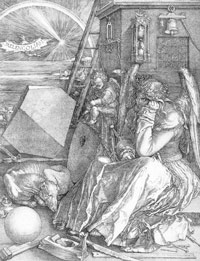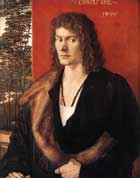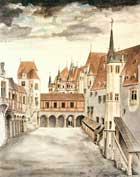Albrecht Dürer Engravings
The engravings of Albrecht Dürer “amazed all who beheld them,” as Vasari says. They amaze us even today by their power, boldness, and marvellous execution, and by the new and strange ideas they convey. After all, Dürer is best known due to his engravings. “Knight, Death, and the Devil,” the “Melencolia”, the “St. Eustace,” and “Adam and Eve” are some of his most remarkable works.

Melencolia I
Dürer’s genius is at its greatest freedom, and is more powerfully revealed in his engravings than in any other of his works. Disobeying the conventional bonds of the time, his engravings express his doubts and despairs in a time when the old beliefs were shaken by Reformation. His works are an expression of a reforming age.
The idea of Death have been ever lurking in Durer's mind, and his engravings reveal that the soul of the artist was influenced by the sadness of the preacher.
Some of his engravings are symbolical, some have a deep underlying meaning, not easy to read, as the artist’s mind was a profound one. Whenever you think you are looking at a realistic representation of German life, a strange suggestion is lurking, a hint at an unknown mystery is all of a sudden setting the meaning of the work in the realm of imagination.
That peculiar element of the German art, the “fantastic element,” originating in the old Scandinavian mythology, with its valkyries, its ice giants, its world serpent, finds a fertile environment in Dürer’s works. The artist loves to travel into wonderland, and to describe his findings: fantastic shapes and unearthly beings.
He especially delights in exploring the animal kingdom, and introduces the animals into many of his sacred subjects. As such, he represents even his Virgins and holy personages surrounded by animals. One of his Madonnas is the watercolor known as “The Virgin with a Multitude of Animals.” Here the artist includes several owls, a parrot, small birds of all kinds, a fox, a dog, a butterfly, a stag-beetle, a crab, a frog, a snail, a dragon-fly, a stork, two geese, and a donkey.
No one can thoroughly understand Dürer’s art unless they try to really understand the artist’s mind, and regard this strange tendency to fantastic as one of its chief particularities and charms.
If we do not do that, the art of Dürer might seem rude at times, and many criticized him for not paying attention to ancient art, like the Venetians did. Vasari, in trying to excuse the “rudeness” of some of the artist’s works, explained that he used apprentices in the study of the nude, and that is why the results are so poor. Let alone many other critics who stated that Dürer would have been a greater artist if he had Italian training and had taken the antiquity as a model, especially the Greek art.
Even one of the most appreciative critics of his art, Kugler, blames his tendency to fantastic as the main obstacle to the pure development of his artistic power. But, here is the problem. All these critics were looking for the apparent, striking beauty, in “Italian” terms.
And, truth is, beauty in the ordinary sense of the world, is not characterizing Dürer’s art. We cannot compare his Madonnas with those of Raphael, and the strange figure of Melencolia is certainly not beautiful. But, it cannot be stressed strongly enough, when looking at Albrecht Dürer’s works, we need to look for the mystery and hidden meaning, which is generally a characteristic of the German art.
There is sort of a mysterious fascination with all of Albrecht Dürer’s engravings. They suddenly capture our attention, even when contemplating other beautiful creations of art, and summon us to listen to their sad and strange message.



